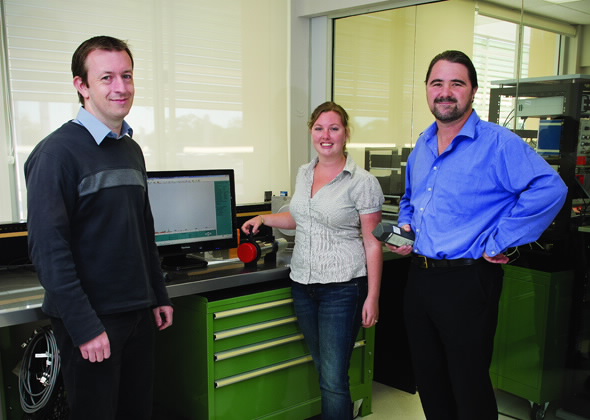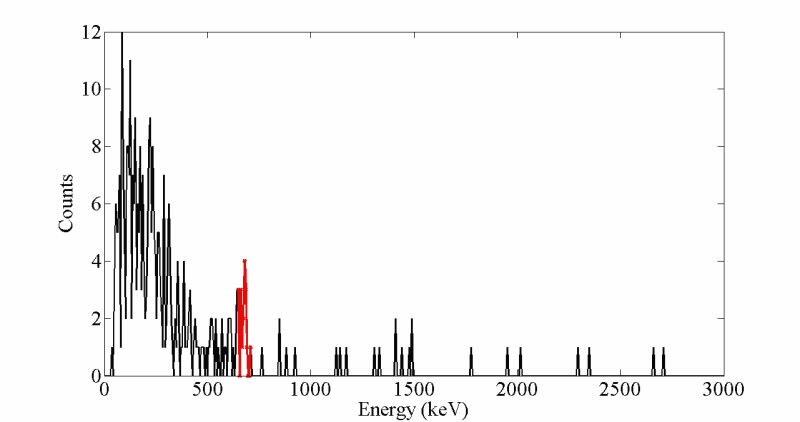The illicit trafficking of radiological and nuclear material is a major concern for the international community. In the near future the United States will require all trade partners to perform passive radiation screening on 100% of cargo at the country of origin.
 |
| Researchers are improving the identification of radiological and nuclear materials. |
However, the high false or nuisance alarm rates of current radiation detection systems negatively impact the flow of legitimate trade through the ports.
Furthermore, the potential failure to detect the presence of illicit radioactive material is of even greater concern. Our research has led to the development and evaluation of a new technology in the form of identification algorithms that address these issues and maintains a high true positive alarm rate whilst minimising the false positive alarm rate.
This research will contribute directly to national and international security. Evaluations of commercially available radiation portal monitors for detecting radioactivity have demonstrated a high rate of false alarm [1, 2]. This is mainly due to short measurement acquisition times required for broader security applications.
The small detector volumes imposed by cost restraints can also limit the statistical quality of the measured gamma-ray spectra. Fig. 1 shows an example of the low statistic sodium iodide spectra that have been obtained from a handheld radionuclide identifier.
Traditional radionuclide identification software based on peak search algorithms is unable to detect the presence of 137Cs, due to the low number of counts in the 137Cs peak at 662 keV.
Using a special computation method: FLDA algorithm
Fisher Linear Discriminant Analysis (FLDA) is a multivariate statistical analysis technique that has typically been used as a classification and/ or dimensionality-reduction technique and is used in pattern recognition. The dimensionality reduction properties of FLDA mean that the original data with 512 energy bins (variables) can be represented in a new single variable (i.e. reducing 512 dimensions down to 1).
FLDA can generate loading coefficients (weighting factors) that maximise the separation between userdefined classes. For our work, a multiple two class FLDA approach was used in order to generate the energybin weighting factors that maximise the separation between one source and all other sources in a training data library. Each of these loading coefficients are subsequently used to project (or transform) the unknown measured spectra.
Fig. 2 illustrates the projection of various gamma-ray spectra by the loading coefficients for 137Cs and 133Ba. If a particular source is present then it is separated from all the other sources along its corresponding loadingcoefficient axis. All the other sources, which do not contain 137Cs or 133Ba, tend to cluster around a single point. The standard deviation in the cluster distribution varies as the inverse square-root of the mean grosscounts, so the source separation becomes more pronounced as the number of counts increase.
Performance validation
The North American standard (ANSI N42.34) for handheld radionuclide identifiers requires that each radionuclide must be identified in 8 out of 10 trials in a minimum of 120 s for a dose rate of 0.5 μSv/h [3]. The validation of the algorithm performance, against these requirements, has been done with experimental and semi-empirical synthetic spectra.
Table 1 shows the identification performance for 100 spectra of each of the given radionuclides. The analysed spectra were for a 10 s acquisition time of a radionuclide dose rate of 0.05 μSv/h in the presence of a 0.1 μSv/h background.
For the threat radionuclides, the identification performance typically meets the ANSI N42.34 requirements for a dose rate and acquisition time that are an order of magnitude lower. There were also no false alarms in the analysed spectra.
The results presented are for a NaI detector, however the FLDA algorithm performance has shown an improved identification performance for lanthanum bromide and high-purity germanium detectors that have an improved energy resolution. The FLDA algorithm has shown high potential for the accurate identification of threat radionuclides which is maintained for count starved spectra.
The algorithm could be used in border monitoring applications that require a high sensitivity to threats, but also require low false and nuisance alarm rates which will maintain the flow of commerce at ports of entry.
 |
| Fig 1. A typical low count 137Cs spectrum aquired by a Nal detection system. The red highlighed region shows where the 137Cs peak occurs. |
 |
| The projection of various gamma-ray spectra by the loading coefficients for 137Cs and 133Ba. If a particulr source is present then ii s separated fromall the other sources along its corresponding loadin-coeffecitent axis. Al the otehr sources, which not contain 137Cs and 133Ba, tend to cluster around a single points. |
| Dose Rate | 241A | 133Ba | 57Co | 60Co | 137Cs | DU | HEU | 40K | 237Np | 226Ra | 90Sr | 232Th |
| 0.05 | 100 | 100 | 100 | 100 | 100 | 96 | 100 | 100 | 100 | 26 | 100 | 0 |
| The true positive identification results for 0.05 mSv/h and an acquisition time of 10 s. No fale positive alarms were recorded/. |
References
- J. M. Blackadar, S. E. Garner, J. A. Bounds, W. H. Casson, and D. J. Mercer, “Evaluation of Commercial Detectors,” Los Alamos National Laboratory 2003.
- L. Pibida, M. Unterweger, and L. R. Karam, “Evaluation of handheld radionuclide identifiers,” Journal of Research of the National Institute of Standards and Technology, vol. 109, pp. 451-456, 2004.
- ANSI, “American National Standard Perofrmance Criteria for Hand-Held Instruments for the Detection and Identification of Radionuclides,” vol. N42.34, 2006.
Published: 28/05/2012


